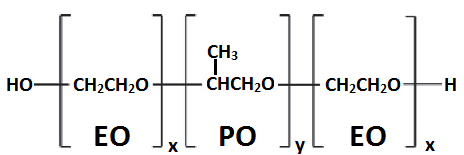The influence of Pluronics® on dark cytotoxicity, photocytotoxicity, localization and uptake of curcumin in cancer cells: studies of curcumin and curcuminoids XLIX.
Ravinder Singh, Hanne Hjorth Tønnesen, Solveig Kristensen and Kristian Berg
Photochem. Photobiol. Sci., 2013, 12, 559-575
Formulation by amphiphilic copolymers, e.g. nonionic Pluronics®, that spontaneously form nanoparticulate micellar carriers (10-100 nm) in aqueous media is one possible strategy to solubilize lipophilic photosensitizers and improve bioavailability, as investigated in this paper by in vitro cellular studies. Pluronics consist of hydrophilic poly-ethylene oxide (EO) and hydrophobic poly-propylene oxide (PO) blocks arranged in a sequential manner (Figure 1).

Figure 1. Pluronic block copolymers, x = number of ethylene oxide groups (EO), y = number of propylene oxide groups (PO).
Pluronics form micelles with a hydrophobic core and hydrophilic corona when individual polymer chains spontaneously assemble into nanosized aggregates above a certain concentration (critical micelle concentration, cmc) and temperature (critical micelle temperature, cmt). The self-assembly of amphiphilic polymers is a reversible process. However, owing to a prolonged in vivo circulation time prior to dissociation, a high solubilizing capability and low toxicity, several Pluronics are approved for oral or intravenous administration, e.g. by the US Food and Drug Administration.

From left to right: Ravinder Singh, Hanne Hjorth Tønnesen, Solveig Kristensen and Kristian Berg
The Pluronic block composition will influence polymeric lipophilicity, micellar aggregation number, shape and size, cmc and cmt values, drug loading and localization, and the release of drug from the formulation. A proper selection of the polymeric blocks may enable development of optimized drug formulations with enhanced accumulation of the selected photosensitizer in cancer cells, as studied in this paper by formulation of the highly lipophilic photosensitizer Curcumin with selected Pluronics.
The field of pluronics has excited much interest lately, not least for the potential of these interesting polymers to assist in targeting cancer calls. The paper described above is an excellent example of how “pluronics” can be applied to improve targeting of photosensitisers in to cells and was one of the most accessed PPS articles on the Royal Society of Chemistry’s website last year.










